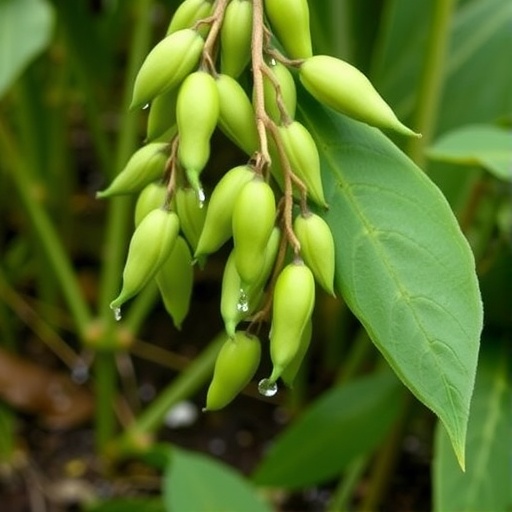In an exciting development in plant biotechnology, researchers led by Zhou and colleagues have unveiled new insights into the role of pathogenesis-related protein-1 (PR1) genes in the mung bean species, Vigna radiata, particularly in its response to the aggressive fungal pathogen, Pythium myriotylum. This study, published in BMC Genomics, positions itself at the forefront of agricultural science, providing critical knowledge that could potentially enhance crop resilience against critical plant diseases.
Mung bean, a staple in many Asian diets, holds significant nutritional value, reaffirming the importance of developing robust agricultural practices as global populations continue to grow. In the research, a comprehensive analysis of the PR1 gene family in mung beans endeavors to elucidate how these proteins mediate plant defense mechanisms. Understanding gene function in disease resistance can fundamentally shift practices in plant breeding, ensuring crops are less susceptible to various pathogens.
The PR1 gene family is well-acknowledged for its role in the plant’s defense response, particularly during biotic stress. Through the activation of these genes, plants can produce proteins that exhibit antifungal properties. The Zhou et al. study meticulously examined these genes, employing advanced genomic techniques to identify their unique functions. By delving into gene expression profiles, the researchers highlighted a remarkable correlation between PR1 expression levels and the plant’s resilience against Pythium myriotylum.
One of the major highlights of the study was the identification of specific PR1 genes that exhibited significantly heightened expressions in response to the fungal threat. By exposing mung bean plants to Pythium myriotylum, the team quantitatively assessed the activation levels of various PR1 genes over time. This time-course analysis revealed a dynamic response, characterized by rapid expression changes that underscore the plant’s immediate efforts to fend off pathogen attacks.
Interestingly, the research team also provided insights into the potential mechanisms underpinning the enhanced expression of these PR1 genes. It is believed that signaling pathways involving plant hormones such as jasmonic acid and salicylic acid play pivotal roles in modulating gene expression during pathogen exposure. This aspect of the study could lead to a deeper understanding of the interconnectedness of hormonal signaling and disease resistance, allowing future researchers to devise strategies that leverage these pathways for crop improvement.
Beyond direct disease resistance, the implications of these findings also extend to agricultural practices. As farming increasingly faces pressures from climate change and emerging pathogens, understanding the genetic basis of disease resistance becomes paramount. The insights from Zhou et al. pave the way for breeding programs aimed at enhancing the genetic makeup of mung beans and possibly other crop species through marker-assisted selection.
Moreover, the researchers’ approach also involved components of gene editing and biotechnological innovation. Advances in CRISPR technology may allow for precise modifications of the PR1 genes, enabling the development of mung bean varieties that possess enhanced antifungal properties. This could revolutionize agricultural methods, decreasing the need for chemical fungicides and promoting sustainable farming practices by harnessing the plant’s natural defenses.
In addition to agricultural advantages, the study offers significant implications for food security. As diseases can devastate crops and thereby threaten food supply chains, understanding genetic resistance mechanisms equips farmers and agricultural scientists with tools to better protect crops against pathogens. The burgeoning interest in plant-based proteins, coupled with the nutritional benefits of mung beans, reinforces the importance of ensuring these crops can withstand diseases that threaten their production.
The multifaceted approach taken by the research team exemplifies the future of botanical science. With advancements in genomic techniques, researchers are increasingly able to shed light on the intricacies of plant defense mechanisms at an unprecedented level. The integration of computational biology and advanced analytical techniques means researchers are equipped to navigate the complex landscapes of plant genetics to unveil how specific genes function and interact.
As publications such as the one by Zhou and colleagues circulate throughout the scientific community, the importance of collaboration and data sharing becomes evident. By disseminating results that highlight critical genetic functions in plants, researchers not only contribute to their own fields but also enrich the broader agricultural and ecological communities. This fosters a culture of innovation and accelerated discovery that can lead to fundamental shifts in how crops are cultivated and protected.
The research conducted by Zhou et al. is a testament to the power of genetic research in addressing some of the pressing challenges faced in agriculture today. By systematically dissecting gene functions in response to pathogens, scientists are uncovering the underlying principles that govern plant immunity—into knowledge that can be turned into actionable strategies for farmers globally.
As we look to the future of agriculture, studies like this one underscore the necessity of integrating biotechnology with traditional farming practices. The fusion of these disciplines will be essential in building crops that are not only high-yielding but also resilient to disease, enabling a sustainable pathway toward meeting the nutritional demands of an ever-growing world population.
In conclusion, the functional evaluation of PR1 genes in mung beans serves as a critical link to advancements in agricultural biotechnology. As researchers build on these findings, the potential thrives not only for crop enhancement but also for global food security initiatives. The call to action for scientists is clear— to continue unraveling the complex genetic tapestry that underlies plant defense mechanisms, crafting a resilient future for crops in an uncertain world.
Subject of Research: Functional evaluation of PR1 genes in mung bean’s response to Pythium myriotylum.
Article Title: Functional evaluation of pathogenesis-related protein-1 (PR1) genes in mung bean (Vigna radiata) response to Pythium myriotylum.
Article References: Zhou, Y., Chen, Y., Liu, X. et al. Functional evaluation of pathogenesis-related protein-1 (PR1) genes in mung bean (Vigna radiata) response to Pythium myriotylum. BMC Genomics 26, 989 (2025). https://doi.org/10.1186/s12864-025-12185-6
Image Credits: AI Generated
DOI: https://doi.org/10.1186/s12864-025-12185-6
Keywords: Mung Bean, PR1 Genes, Pythium Myriotylum, Plant Defense, Crop Resilience, Genetic Engineering.
Tags: agricultural science innovationsbiotic stress response mechanismscrop resilience enhancementfungal pathogen resistancegene function in disease resistancegenomic techniques in agriculturepathogenesis-related proteinsplant biotechnology advancementsplant breeding practicesPR1 genes in mung beanPythium myriotylum interactionVigna radiata research





